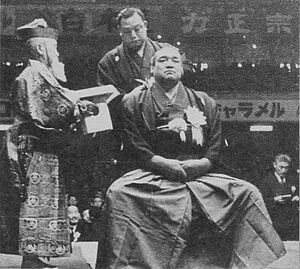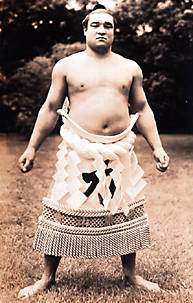Haguroyama Masaji facts for kids
Haguroyama Masaji (Japanese: 羽黒山 政司, November 18, 1914 – October 14, 1969) was a famous Japanese professional sumo wrestler. He was born in Nakanokuchi, Niigata. Haguroyama became the 36th yokozuna, which is the highest rank in sumo. He held this top rank for over twelve years. This was a record until another great wrestler, Hakuhō, broke it in 2019. During his career, Haguroyama won seven major sumo tournaments. He also finished second six times. Even with all his wins, he was often compared to another yokozuna, Futabayama. They both trained at the same sumo stable. After he stopped wrestling, Haguroyama became the main coach of Tatsunami stable until he passed away in 1969.
Haguroyama's Sumo Journey
Haguroyama's birth name was Kobayashi Masaji. He started his professional sumo career in January 1934 when he was 19 years old. He joined the Tatsunami stable. His rise through the sumo ranks was incredibly fast! He won the championship in every lower sumo division. He moved up through each division in just one tournament. This is a very rare achievement in sumo history.
He reached the top makuuchi division in May 1937. After only one tournament at the sekiwake rank, he was promoted to ōzeki. This is the second-highest rank in sumo. He was the first wrestler from Niigata Prefecture to become an ōzeki in 90 years!
After finishing second in the January 1941 tournament, he won his first top division title in May 1941. Because of this big win, he was promoted to yokozuna. He then finished second three more times. He finally won his first championship as a yokozuna in May 1944.
Becoming a Top Champion
When his rival Futabayama retired in November 1945, Haguroyama became the most dominant wrestler. He won four tournaments in a row! However, in November 1947, he hurt his Achilles tendon. This injury kept him out of action until May 1949.
He won his last championship in January 1952. He was 37 years old at the time. He won every single match in that tournament, finishing with a perfect 15–0 record. This was his first tournament win in over four years. He retired from sumo in September 1953, when he was almost 39.
Haguroyama was famous for his intense training. People said he was "made of steel" because of his great strength.
Life After Sumo

Haguroyama married the daughter of his stablemaster. This allowed him to become the head coach of Tatsunami stable after he retired from wrestling. He helped train many strong wrestlers. One of them became an ōzeki named Wakahaguro. When Haguroyama passed away in 1969, his son-in-law, a former sekiwake named Annenyama, took over as the head of Tatsunami stable.
See also
- Glossary of sumo terms
- List of past sumo wrestlers
- List of sumo tournament top division champions
- List of yokozuna


